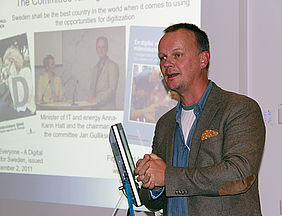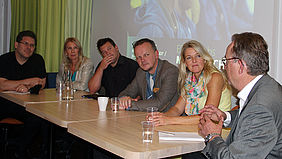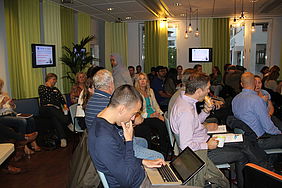What can we learn from shared experiences and standardization work when developing new systems, products and services? Can we get happy users by implementing human-centered design processes?
An expert panel with representatives from education, research and business elaborated on Usability at EIT ICT Labs Stockholm Co-location Centre on September 17. The event jointly organized with Dataföreningen Stockholm (DFS) and Swedish Standards Institute (SIS) was moderated by Dr Mario Romero, KTH and gathered students, researchers, interaction designers, system developers as well as test and change managers from SMEs and larger companies such as H&M, SAAB, Sogeti and Tieto.
Project and change manager Anki Josefsson, presented lessons learnt in the implementation of the Swedish Police ICT system-PUST. The project group followed good procedures for usability testing but when the project was finalized the organization decided to change the technical platform without understanding the importance of involving the end users in the process. The panel discussed if and how an ISO standard for usability could have helped in this case.
The knowledge about and value of usability definitions and standards are not widely spread. Tomas Berns explained how usability standards work and how collaboration with different standards is conducted internationally. Nowadays, the focus is on processes rather than products. He also described a trend, more dominant in Asia than in Europe, in defining standards based on competences in human-system-interaction.
How do we measure Usability and who is the user?
Usability is usually measured by any of four main parameters – the users, tasks, goals and the context. By following a user-centered process with many iteration rounds you will more likely save money and time otherwise spent on systems that are not user friendly, stated Jan Gulliksen, Professor in HCI at KTH, active in standardization workgroups and chairman of the Swedish commission for Digitalization.
- There is an international standard on innovation defining the process which may be useful. I think the best use of standards is for educational purposes. We provide students with free access to standards during their courses. If politicians understood the value for society they should make all standards free of charge and thus used by many more.
Defining who the user is and handle users with various demands can be a problem – or an opportunity.
- In the area of Mobile services, which is my research focus area, said Konrad Tollmar, Associate Professor in HCI at KTH, we actually view the many user groups as part of the new business models. In the case of developing apps it is easy to adapt to various usability aspects and we can create a whole set of products instead.
Why repeat other persons mistakes when you can make your own? How can the standards organizations work be communicated better?
- The best communication is a good business case, stated Mats Berglind, Tieto in the panel. Just sharing the story of the police system makes more people aware and addressing a risk is also a chance to argue for more resources.
The organization of an event such as this after work seminar is a way to reach out to a larger audience concluded Thomas Berns and Björn Nilsson from SIS who also pointed out that the standardization organizations are NGOs and that the workgroups consists of unpaid professional experts who contribute to better processes and products.
Dataföreningen, a non-profit network organization, are focusing on UX this fall in collaboration with the student organization for human computer interaction in Sweden, STIMDI.
Learn more about education in Human Computer Interaction Design
Learn more about standards for Human System Interaction
Learn more about World Usability Day on November 14









